-

部编人教版三年级下册《习作七 国宝大熊猫》说课稿
一、说教材本单元习作的话题是"国宝熊猫",引导学生根据问题查找信息并尝试学习整合有关信息。熊猫教材编排了三个部分内容,第一部分教材首先提供了关于大熊猫许多小朋友都想了解的三个问题,使得本次习作具有更强的针对性,教材呈现的三个问题,有的指向熊猫的,有的指向熊猫的生活的地方,而熊猫为什么被视为"中国的国宝",则指向熊猫的价值,他们只是问题罗列,是小朋友可能提出问题的一部分,其作用是让学生从这些问题受到启发,打开思路继续提出自己有兴趣的问题,第二部分首先明确了本次习作的任务就是围绕这个话题介绍一下熊猫,为介绍大熊猫奠定了基础。二、说教学目标1、针对教材提出的问题,搜集国宝大熊猫的相关资料信息。2、初步学习整合信息,从不同方面介绍国宝大熊猫。3、走进国宝大熊猫,学习整合信息,从不同方面了解大能猫。三、说教学重难点教学重点∶初步学习整合大熊猫的信息,结合资料,从自己感兴趣的方面介绍国宝大熊猫。教学难点∶利用搜集的信息,按一定的顺序准确地介绍大熊猫。
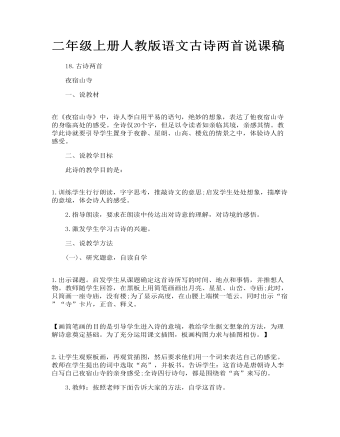
二年级上册人教版语文古诗两首说课稿
二、说教学目标 此诗的教学目的是: 1.训练学生行行朗读,字字思考,推敲诗文的意思;启发学生处处想象,揣摩诗的意境,体会诗人的感受。 2.指导朗读,要求在朗读中传达出对诗意的理解,对诗境的感悟。 3.激发学生学习古诗的兴趣。 三、说教学方法 (一)、研究题意,自读自学 1.出示课题。启发学生从课题确定这首诗所写的时间、地点和事情,并推想人物。教师随学生回答,在黑板上用简笔画画出月亮、星星、山峦、寺庙;此时,只简画一座寺庙,没有楼;为了显示高度,在山腰上端横一笔云。同时出示“宿”“寺”卡片,正音、释义。 【画简笔画的目的是引导学生进入诗的意境,教给学生据文想象的方法,为理解诗意奠定基础。为了充分运用课文插图,板画构图力求与插图相仿。】 2.让学生观察板画,再观赏插图,然后要求他们用一个词来表达自己的感觉。教师在学生提出的词中选取“高”,并板书。告诉学生:这首诗是唐朝诗人李白写自己夜宿山寺的亲身感受;全诗四行诗句,都是围绕着“高”来写的。
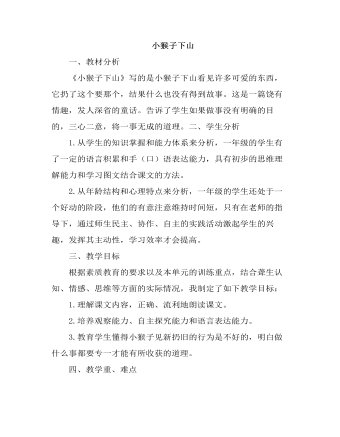
部编人教版一年级下册《小猴子下山》(说课稿)
三、教学目标根据素质教育的要求以及本单元的训练重点,结合聋生认知、情感、思维等方面的实际情况,我制定了如下教学目标:1.理解课文内容,正确、流利地朗读课文。2.培养观察能力、自主探究能力和语言表达能力。3.教育学生懂得小猴子见新扔旧的行为是不好的,明白做什么事都要专一才能有所收获的道理。四、教学重、难点本课的关键是必须处理好形象的图和抽象的文字之间的关系,因为只有图文紧密结合了,才能使学生了解小猴子活动的顺序和事物之间的联系,从而有效的发展学生的语言和思维。五、说教法、学法1.教法结合学生的个体差异和不同的学习需求,依据本课故事性强,画面丰富,结构类似的特点,我主要采取了以下教学方法:(1)图文结合的情景教学法。(2)以扶为主的扶放教学法。(3)读思结合的品读感悟法。
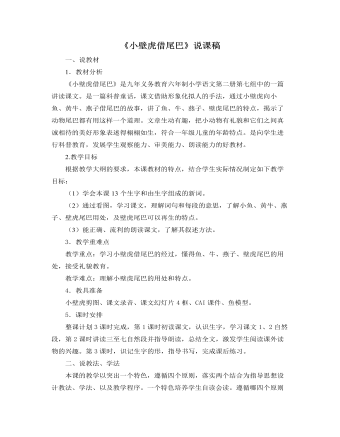
部编人教版一年级下册《小壁虎借尾巴》说课稿
2.教学目标根据教学大纲的要求,本课教材的特点,结合学生实际情况制定如下教学目标:(1)学会本课13个生字和由生字组成的新词。(2)通过看图,学习课文,理解词句和每段的意思,了解小鱼、黄牛、燕子、壁虎尾巴用处,及壁虎尾巴可以再生的特点。(3)能正确、流利的朗读课文,了解其叙述方法。3.教学重难点教学重点:学习小壁虎借尾巴的经过,懂得鱼、牛、燕子、壁虎尾巴的用处,接受礼貌教育。教学难点:理解小壁虎尾巴的用处和特点。4.教具准备小壁虎剪图、课文录音、课文幻灯片4框、CAI课件、鱼模型。5.课时安排整课计划3课时完成,第1课时初读课文,认识生字,学习课文1、2自然段,第2课时讲读三至七自然段并指导朗读,总结全文,激发学生阅读课外读物的兴趣。第3课时,识记生字的形,指导书写,完成课后练习。
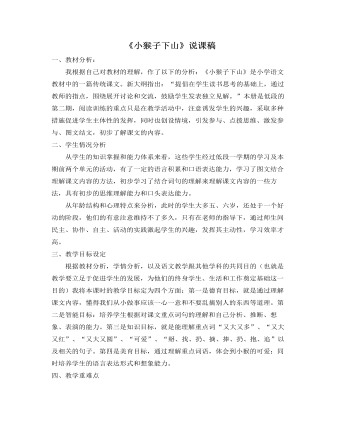
部编人教版一年级下册《小猴子下山》说课稿
二、学生情况分析从学生的知识掌握和能力体系来看,这些学生经过低段一学期的学习及本期前两个单元的活动,有了一定的语言积累和口语表达能力,学习了图文结合理解课文内容的方法,初步学习了结合词句的理解来理解课文内容的一些方法,具有初步的思维理解能力和口头表达能力。从年龄结构和心理特点来分析,此时的学生大多五、六岁,还处于一个好动的阶段,他们的有意注意维持不了多久,只有在老师的指导下,通过师生间民主、协作、自主、活动的实践激起学生的兴趣,发挥其主动性,学习效率才高。三、教学目标设定根据教材分析,学情分析,以及语文教学跟其他学科的共同目的(也就是教学要立足于促进学生的发展,为他们的终身学生、生活和工作奠定基础这一目的)我将本课时的教学目标定为四个方面:第一是德育目标,就是通过理解课文内容,懂得我们从小做事应该一心一意和不要乱摘别人的东西等道理。第二是智能目标:培养学生根据对课文重点词句的理解和自己分析、推断、想象、表演的能力。第三是知识目标,就是能理解重点词“又大又多”、“又大又红”、“又大又圆”、“可爱”、“掰、找、扔、摘、捧、扔、抱、追”以及相关的句子。第四是美育目标,通过理解重点词语,体会到小猴的可爱;同时培养学生的语言表达形式和想象能力。
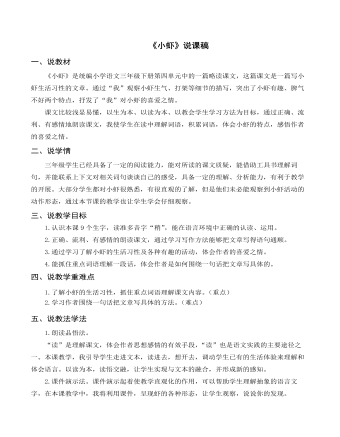
(说课稿)部编人教版三年级下册《小虾》
一、说教材《小虾》是统编小学语文三年级下册第四单元中的一篇略读课文,这篇课文是一篇写小虾生活习性的文章。通过“我”观察小虾生气、打架等细节的描写,突出了小虾有趣、脾气不好两个特点,抒发了“我”对小虾的喜爱之情。 课文比较浅显易懂,以生为本、以读为本、以教会学生学习方法为目标,通过正确、流利、有感情地朗读课文,我使学生在读中理解词语,积累词语,体会小虾的特点,感悟作者的喜爱之情。二、说学情三年级学生已经具备了一定的阅读能力,能对所读的课文质疑,能借助工具书理解词句,并能联系上下文对相关词句谈谈自己的感受,具备一定的理解、分析能力,有利于教学的开展。大部分学生都对小虾很熟悉,有很直观的了解,但是他们未必能观察到小虾活动的动作形态,通过本节课的教学也让学生学会仔细观察。
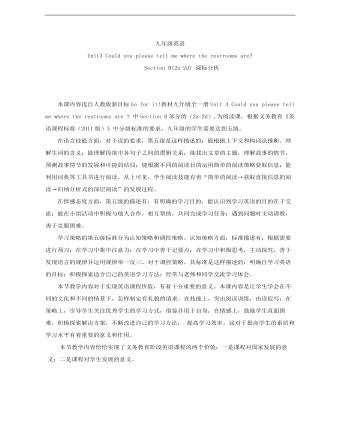
初中英语人教版九年级全册《Unit 3 Could you please tell me where the restrooms are》课标分析说课稿
学习策略的第五级标准分为认知策略和调控策略。认知策略方面,标准描述有:根据需要进行预习;在学习中集中注意力;在学习中善于记要点;在学习中积极思考,主动探究,善于发现语言的规律并运用规律举一反三。对于调控策略,其标准是这样描述的:明确自学习英语的目标;积极探索适合自己的英语学习方法;经常与老师和同学交流学习体会。
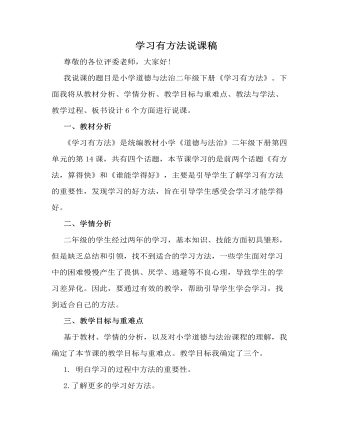
人教部编版道德与法制二年级下册学习有方法说课稿
设计意图:发现身边更多的学习好方法。活动三:巩固学习的好方法课件出示儿歌《学习好方法》,学生填空后,齐读儿歌。设计意图:学以致用,巩固学习的好方法。环节三:感悟明理,育情导行学生谈一谈学习本节课的收获,教师相机引导。设计意图:梳理总结,体验收获与成功的喜悦,内化提升学生的认识与情感。环节四:拓展延伸,回归生活以小组为单位,将各组总结的学习好方法张贴到板报上。设计意图:将课堂所学延伸到学生的日常生活中,有利于落实行为实践。六、板书设计为了突出重点,让学生整体上感知本节课的主要内容,我将以思维导图的形式设计板书:在黑板左面的中间位置是课题《学习有方法》,右面从上到下依次是专心听讲、细心观察、珍惜时间、持之以恒、节约时间。

人教部编版道德与法制三年级下册同学相伴说课稿
一、教材分析《同学相伴》是统编教材小学《道德与法治》三年级下册第一单 元第 4 课,共有两个话题,本节课学习的是第一个话题《同学相伴的 快乐》,主要是引导学生体会同学在一起共同游戏、共同生活中的快乐,旨在引导学生愿意与同伴在一起,体会乐群的意义。 二、学情分析三年级的学生在两年半的校园生活中,在与同学相伴方面,已经积累了较多的生活经验和体验,但他们还不能从理性上理解共同生活对于个体的意义。因此,要通过有效的教学,帮助引导学生体会同学相伴的快乐和乐群的意义。三、教学目标与重难点 基于教材、学情的分析,以及对小学道德与法治课程的理解,我确定了本节课的教学目标与重难点。教学目标我确定了三个。1. 体会同学相伴的快乐。2. 懂得同学相伴的重要性。3. 乐于在生活中与同学合作、分享。教学重点是:体会同学相伴的快乐和乐群的意义。
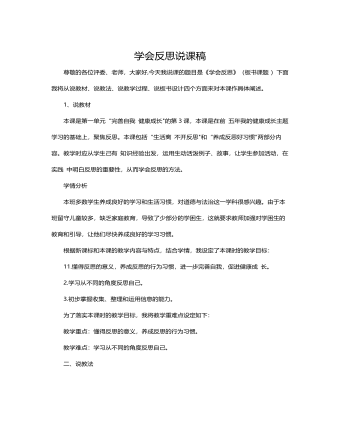
人教部编版道德与法制六年级下册学会反思说课稿
1、说教材本课是第一单元“完善自我 健康成长"的第3课,本课是在前 五年我的健康成长主题学习的基础上,聚焦反思。本课包括“生活离 不开反思"和“养成反思好习惯"两部分内容。教学时应从学生己有 知识经验出发,运用生动活泼例子、故事,让学生参加活动,在实践 中明白反思的重要性,从而学会反思的方法。学情分析本班多数学生养成良好的学习和生活习惯,对道德与法治这一学科很感兴趣。由于本班留守儿童较多,缺乏家庭教育,导致了少部分的学困生,这就要求教师加强对学困生的教育和引导,让他们尽快养成良好的学习习惯。根据新课标和本课的教学内容与特点,结合学情,我设定了本课时的教学目标:11.懂得反思的意义,养成反思的行为习惯,进一步完善自我,促进健康成 长。2.学习从不同的角度反思自己。3.初步掌握收集、整理和运用信息的能力。
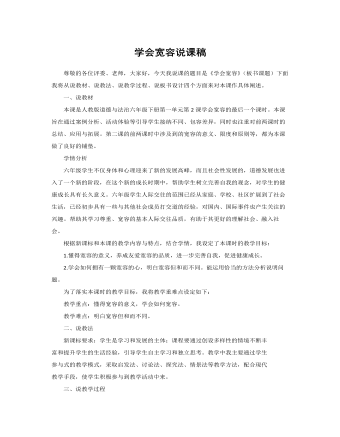
人教部编版道德与法制六年级下册学会宽容说课稿
①假如因为有第1条虫子,让我愤怒而无法黄谷他人,我会……②假如因为有第2条虫子,让我想要报复他人,我会……③假如因为有第3条虫子,让我不愿意原谅他人,我会……读一读,想一想。1.读P17案例。2.想一想:①案例1中,班主任的做法是否过于严厉,你认为冒犯他人人格和尊严的行为,可以宽容吗??②案例2中,如果小明的家人不严格要求小明,而是纵容他的玩火行为,可能会导致什么样的后果?活动三:和而不同读案例,谈体会。1.阅读pl8情景,分析原因。分析:六2班的战火因为什么而烧起来,这时班级的和谐有什么影响?2.谈体会。召开主题班会。1.召开班会:针对六2班出现的问题,班主任设计了“营建和谐宽容的班级生活”的主题班队活动,让我们一起参加吧。2.劝说:对于那些不宽容的观点,我们该怎么说服他们呢?教材3. 感悟:通过学习结合实践,谈谈你对宽容的理解。

人教部编版道德与法制六年级下册学会尊重说课稿
6.在我们生活中,同学之间难免会发生一些磕磕绊绊。下面,我们要观看一段视频,视频中小晨与小丰是形影不离的好朋友,一个星期天,两人与同学相约去学校排练班会上表演的一个节目。见时间还早,便下起了棋,下棋下出状况来了一一(播放视频)7.同学们,看了视频,发现是什么原因导致了这样的结果?8.如果你是他们中的一个,发生争执的时候心里只要怎么想,就可能避免发生这样的事呢?9.看来,尊重自己与接受别人的批评是不矛盾的。如果过于爱面子,输不起、说不得,就是过度维护自己。所以,尊重自己,就应该懂得适度维护自己。(板书:适度维护)10.以下哪些行为属于“尊重自己”?哪些属于“过度维护自己”?说说你的理由。(出示书本第七页“活动园”内容)四、总结升华。1.同学们,尊重是人与人交往的起点。尊重自己,需要悦纳自己,需要适度维护,它是一种美德,是人与人之间交流的另一种方式。希望每个同学都能懂得尊重自己,从而赢得别人对你的尊重。
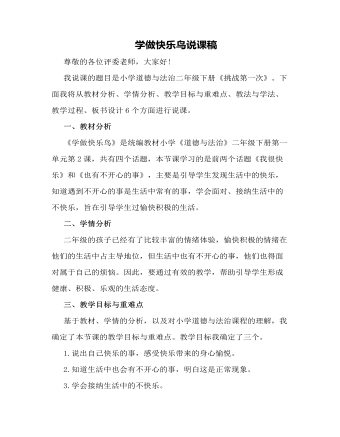
人教部编版道德与法制二年级下册学做快乐鸟说课稿
活动二:说出不开心的事首先,播放视频《我的烦恼》,学生会发现,自己不开心的事在他人身上也会出现。然后,学生说说自己还有什么不开心的事,教师相机引导。板书:生活中也有不快乐。设计意图:引导学生将自己遇到的不开心的事说出来,正确认识、接纳生活中的不快乐。活动三:快乐约定课件出示儿歌《快乐约定》,学生自己诵读,再齐读。设计意图:学以致用,形成积极乐观的生活态度。环节三:感悟明理,育情导行学生谈一谈学习本节课的收获,教师相机引导。设计意图:梳理总结,体验收获与成功的喜悦,内化提升学生的认识与情感。环节四:拓展延伸,回归生活把不快乐的事忘掉,把快乐的事记心里。设计意图:将课堂所学延伸到学生的日常生活中,有利于落实行为实践。
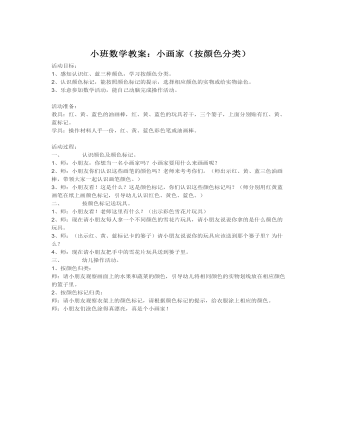
小班数学教案:小画家(按颜色分类)
2、认识颜色标记,能按照颜色标记的提示,选择相应颜色的实物或给实物涂色。 3、乐意参加数学活动,能自己动脑完成操作活动。 活动准备: 教具:红、黄、蓝色的油画棒,红、黄、蓝色的玩具若干,三个篓子,上面分别贴有红、黄、蓝标记。 学具:操作材料人手一份,红、黄、蓝色彩色笔或油画棒。 活动过程: 一、 认识颜色及颜色标记。 1、师:小朋友,你想当一名小画家吗?小画家要用什么来画画呢? 2、师:小朋友你们认识这些画笔的颜色吗?老师来考考你们。(师出示红、黄、蓝三色油画棒,带领大家一起认识画笔颜色。) 3、师:小朋友看!这是什么?这是颜色标记,你们认识这些颜色标记吗?(师分别用红黄蓝画笔在纸上画颜色标记,引导幼儿认识红色、黄色、蓝色。)

新人教版高中英语必修3Unit 1 Festivals and Celebrations教学设计二
1. Ss look at the picture and scan the passage to understand the main idea while teacher is giving the following questions to inspire Ss to think.*Where are those people?*What are they doing?*Why are they so excited?2. Ss complete the passage with the appropriate -ing form. Then discuss and check the answers with class.Answers: boring, interesting, taking, exciting, amazing3. The teacher raises questions for the students to discuss and encourages them to express their opinions.*Do you like La Tomatina? Why or why not?4. Each group representative reports the discussion result, the teacher gives feedback and the evaluation.Step 6 PracticeActivity 41. Ss complete the Ex 2 in Using structures.2. Check the answers after finishing the exercises.①The dragon boat races are the most exciting part of the Dragon Boat Festival.② The children were excited to go Easter egg hunting.③What an amazing performance! This is the best music festival I have ever been to.④We were amazed by her funny-looking hat.⑤His inspiring speech at the conference won the admiration/ favour of the audience.⑥This is a challenging game to test your memory and observation capabilities. 3. T asks Ss to finish Ex 3 and 4 in Using structures by themselves, then check the answers with class.Step 6 Homework1. Understand and master the functions and usage of the -ing form;2. Finish the other exercises in Using structures.1、通过本节内容学习,学生是否理解和掌握动词-ing形式作定语和表语的功能和意义;2、通过本节内容学习,学生能否在理解文段内容的基础上,根据上下文语境和表达逻辑,能正确运用动词-ing形式描述节日庆典。3、通过本节内容学习,学生是否归纳和积累用于表达情绪的相关词汇。

新人教版高中英语必修3Unit 1 Festivals and Celebrations教学设计一
本板块的活动主题是“谈论节日活动”(Talk about festival activities),主要是从贴近学生日常生活的角度来切入“节日”主题。学生会听到发生在三个国家不同节日场景下的简短对话,对话中的人们正在参与或将要亲历不同的庆祝活动。随着全球化的进程加速,国际交流日益频繁,无论是国人走出国门还是外国友人访问中国,都已成为司空见惯的事情。因此,该板块所选取的三个典型节日场景都是属于跨文化交际语境,不仅每组对话中的人物来自不同的文化背景,对话者的身份和关系也不尽相同。1. Master the new words related to holiday: the lantern, Carnival, costume, dress(sb)up, march, congratulation, congratulate, riddle, ceremony, samba, make - up, after all. 2. To understand the origin of major world festivals and the activities held to celebrate them and the significance of these activities;3. Improve listening comprehension and oral expression of the topic by listening and talking about traditional festivals around the world;4. Improve my understanding of the topic by watching pictures and videos about different traditional festivals around the world;5. Review the common assimilation phenomenon in English phonetics, can distinguish the assimilated phonemes in the natural language flow, and consciously use the assimilation skill in oral expression. Importance:1. Guide students to pay attention to the attitude of the speaker in the process of listening, and identify the relationship between the characters;2. Inspire students to use topic words to describe the festival activities based on their background knowledge. Difficulties:In the process of listening to the correct understanding of the speaker's attitude, accurately identify the relationship between the characters.

新人教版高中英语必修3Unit 2 Morals and Virtues教学设计二
Activity 41. Students complete the task of activity 4, then teachers and students check the answers. 2. The teacher organized the students to work together and asked them to use the tables and mind maps sorted out before to retold the important choices in Lin Qiaozhi's life and their resultsStep 5 Language points1. The teacher asks the students to read the text carefully, find out the core words and long and difficult sentences in the text and draw lines, understand the use of vocabulary, and analyze the structure of long and difficult sentences. 2. The teacher explains and summarizes the usage of core vocabulary and asks the students to take notes. 3. The teacher analyzes and explains the long and difficult sentences that the students don't understand, so that the students can understand them better. Step 6 Homework1. Read the text again, in-depth understanding of the text; 2. Master the use of core vocabulary and understand the long and difficult sentences. 3. Complete relevant exercises in the guide plan. 1、通过本节内容学习,学生是否理解和掌握阅读文本中的新词汇的意义与用法;2、通过本节内容学习,学生能否结合文本特点总结林巧稚的人生原则和人格品质特征;3、通过本节内容学习,学生能否针对人生抉择发表自己的看法;能否全面地、客观地、理性地看待问题,进而对道德和人性有更加深入的思考和理解。

新人教版高中英语必修3Unit 1 Festivals and Celebrations教学设计三
*wide range of origins(= a great number of different origins, many kinds of origins)*It featured a parade and a great feast with music, dancing, and sports. (=A parade and a great feast with music, dancing, and sports were included as important parts of the Egyptian harvest festival.)*.. some traditions may fade away and others may be established.(= Some traditions may disappear gradually, while other new traditions may come into being.)Step 6 Practice(1) Listen and follow the tape.The teacher may remind the students to pay attention to the meaning and usage of the black words in the context, so as to prepare for the completion of the blanks in activity 5 and vocabulary exercises in the exercise book.(2) Students complete the text of activity 5 by themselves.The teacher needs to remind the students to fill in the blanks with the correct form of the vocabulary they have learned in the text.Students exchange their answers with their partners, and then teachers and students check their answers.(3)Finish the Ex in Activity 5 of students’ book.Step 7 Homework1. Read the text again, in-depth understanding of the text;2. Discuss the origin of festivals, the historical changes of related customs, the influence of commercial society on festivals and the connotation and essential meaning of festivals.3. Complete relevant exercises in the guide plan.1、通过本节内容学习,学生是否理解和掌握阅读文本中的新词汇的意义与用法;2、通过本节内容学习,学生能否结合文本特点快速而准确地找到主题句;3、通过本节内容学习,学生能否理清论说文的语篇结构和文本逻辑,了解节日风俗发展与变迁,感悟节日的内涵与意义。

新人教版高中英语必修3Unit 2 Morals and Virtues教学设计三
The joke set her crying.这个玩笑使她哭起来。Step 5 ReadingActivity 31. Students read the small text in activity 3. The teacher provides several small questions to check whether students understand the content of the text and the ideographic function of the -ing form in the text.*Where are those people?*Why did Dr Bethune come to China?*How did he help the Chinese people during the war?*What did Chairman Mao Zedong say about him?2. Ss try to rewrite some sentences using the -ing form. Then check the answers. When checking the answers, the teacher can ask different students to read the rewritten sentences and give comments.Answers:1. he became very interested in medicine, deciding to become a doctor.2. …after hearing that many people were dying in the war.3. Helping to organise hospitals, he taught doctors and nurses, and showed people how to give first aid./ He helped to organise hospitals, teaching doctors and nurses, and showing people how to give first aid.4. …praising Dr Bethune as a hero to be remembered in China.Step 6 PracticeActivity 4Students complete grammar activities 2 and 3 on page 69 of the workbook.Step 6 Homework1. Understand and master the functions and usage of the -ing form;2. Finish the other exercises in Using structures.1、通过本节内容学习,学生是否理解和掌握动词-ing形式作宾语补足语语和状语语的功能和意义;2、通过本节内容学习,学生能否正确使用动词-ing形式描述人物的行为、动作及其经历;3、通过本节内容学习,学生能否独立完成练习册和导学案中的相关练习。

新人教版高中英语必修3Unit 2 Morals and virtues教学设计一
(2) students are divided into groups according to the requirements of activity 3. Each student shares a story of personal experience or hearing-witnessing kindness, and then selects the most touching story in the group and shares it with the whole class. Before the students share the story, the teacher can instruct them to use the words and sentence patterns in the box to express. For example, the words in the box can be classified:Time order: first of all, then, after that, later, finally logical relationship :so, however, although, butTeachers can also appropriately add some transitional language to enrich students' expression:Afterwards, afterwards, at last, in the end, eventuallySpatial order: next to, far from, on the left, in front ofOtherwise, nevertheless, as a result, therefore, furthermore, in addition, as well asSummary: in a word, in short, on the whole, to sum up, in briefStep 8 Homework1. Understand the definition of "moral dilemma" and establish a correct moral view;2. Accumulate vocabulary about attitudes and emotions in listening texts and use them to express your own views;3. Complete relevant exercises in the guide plan.1、通过本节内容学习,学生能否理解理解“道德困境”的定义;2、通过本节内容学习,学生能否通过说话人所表达的内容、说话的语气、语调等来判断其态度和情绪;3、通过本节内容学习,学生能否针对具体的道德困境发表自己的看法和见解,能否掌握听力理训练中的听力策略。

